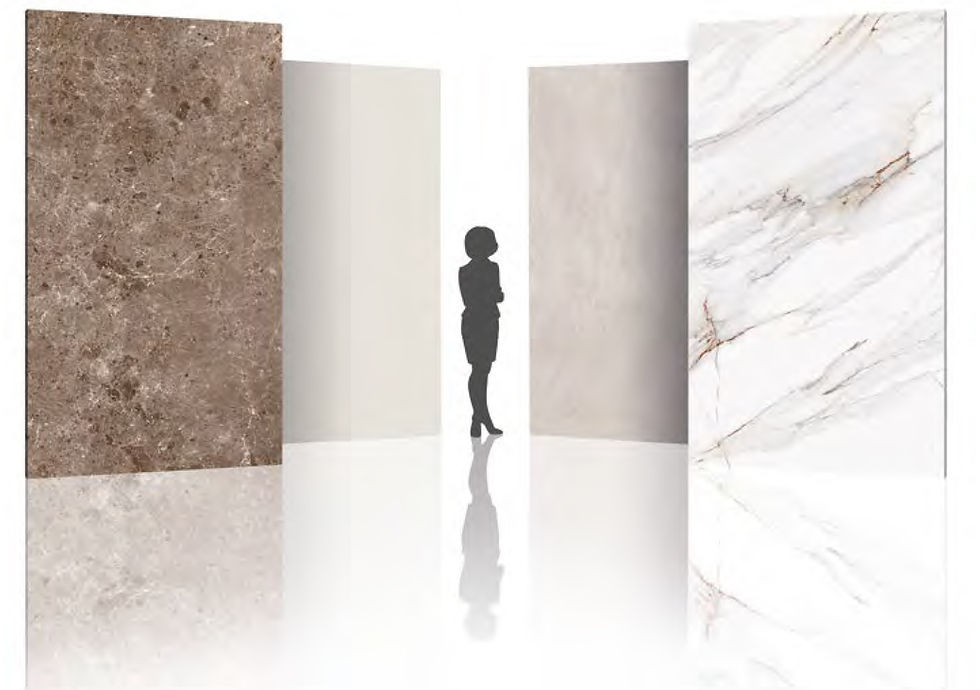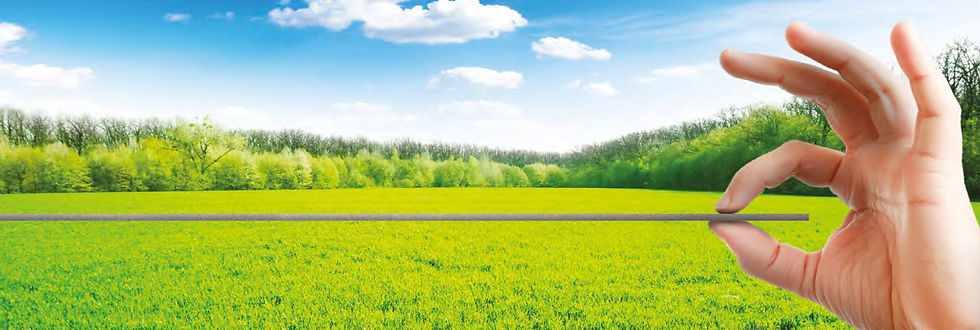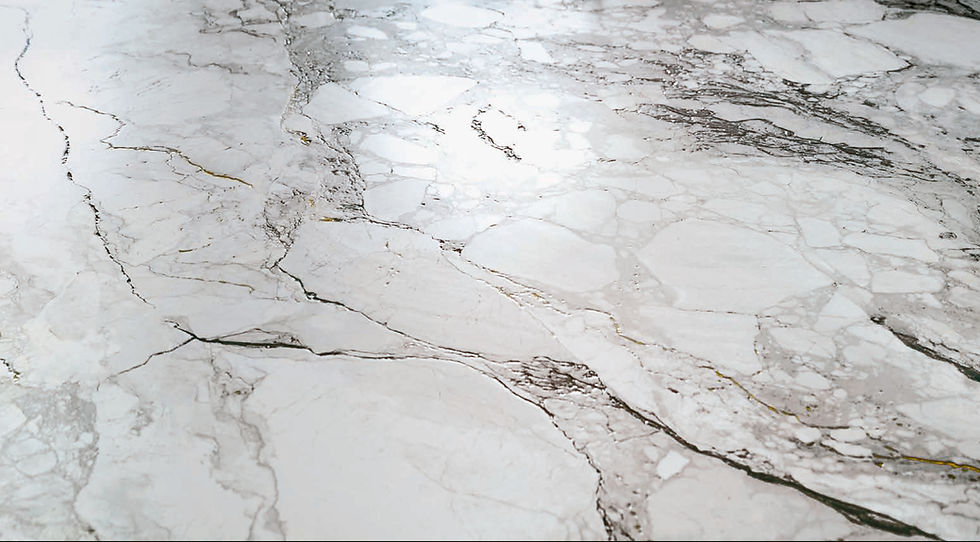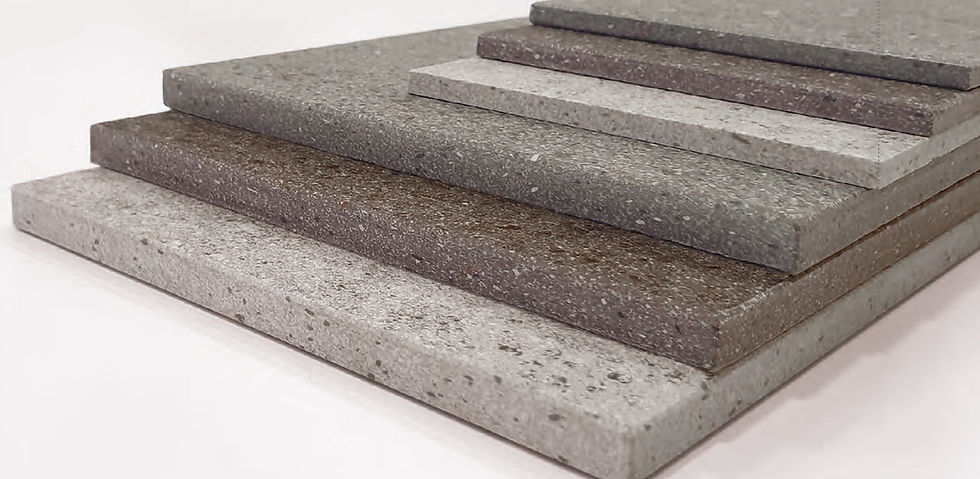Why Sintered Stone is the Next-Generation Alternative to Porcelain Tiles and Ceramic Tiles
- gpgrantswiss
- 3 days ago
- 4 min read
In the world of finishing materials, the terms sintered stone, porcelain tile, and ceramic tile are often confused. At first glance, they seem similar: all are made from minerals and clay, fired at high temperatures, and used for cladding. However, there are fundamental differences between them that directly impact their strength, water resistance, applications, and cost.

1. Composition and Production
Sintered Stone: A blend of natural minerals (quartz, feldspar, silica, metal oxides) compressed under ultra-high pressure and sintered at 1200–1250 °C. The process mimics the natural formation of stone.
Porcelain Tile: Fine clay with minerals, molded and fired at ~1200 °C. It has a denser structure compared to standard ceramic tiles.
Ceramic Tile: Clay with minerals, fired at 1000–1100 °C. Less dense and more porous.
2. Water Absorption
Sintered Stone: ≤ 0.09% (virtually impermeable).
Porcelain Tile: ≤ 0.5%.
Ceramic Tile: 3–10%.

3. Strength and Durability
Sintered Stone: Maximum resistance to scratches, impacts, abrasion, UV radiation, chemicals, and temperature fluctuations.
Porcelain Tile: High strength and durability but slightly more prone to chipping under heavy impacts.
Ceramic Tile: Moderate strength, primarily used for walls.

4. Thickness and Formats
Sintered Stone: From 3 mm (ultra-thin panels) to 30 mm (thick slabs). Large-format sizes, typically 1.6×3.2 m to 1.8×4.8 m, ideal for seamless applications.
Porcelain Tile: Typically 6–10 mm for standard applications, with ultra-thin large-format versions at 3–5 mm for walls or lightweight uses, and up to 12 mm for heavier-duty applications. Sizes range from standard (30×30 cm, 60×60 cm) to large-format (1×1 m, 1.2×2.4 m, up to 1.6×3.2 m).
Ceramic Tile: 6–12 mm, standard sizes like 20×20 cm, 30×60 cm, or 45×45 cm, rarely exceeding 60×120 cm, suited for walls and floors.

5. Applications
Sintered Stone: Facades, floors, walls, kitchen countertops, furniture, high-traffic areas, and exterior use.
Porcelain Tile: Facades, floors, walls, bathrooms, kitchens, and commercial spaces.
Ceramic Tile: Mainly wall coverings, bathrooms, kitchens, and low-traffic areas.
6. Design and Pattern Quality
Sintered Stone: Offers highly realistic, high-resolution patterns mimicking natural stone, wood, metals, concrete, or monochromatic finishes due to advanced digital printing and large-format capabilities. Technologies like CarvedTechnology create synchronized bas-relief effects with indented veins, replicating the tactile and visual reliefs of natural materials like marble and stone for an ultra-natural look. Consistent color and minimal variation across slabs.
Natural materials such as marble and stone have reliefs on their surface displayed in both texture and graphics. Carved technology achieves the utmost realism by giving tiles a very natural look through the synchronized bas-relief effect of indented veins.

Porcelain Tile: Features high-quality printed designs with good detail and variety, often using advanced techniques to mimic natural textures. Some premium lines incorporate bas-relief effects similar to sintered stone, though typically less pronounced. Suitable for realistic stone or wood looks.
Ceramic Tile: Patterns are generally simpler, with less depth and realism compared to sintered stone or porcelain. Surface textures are usually limited to basic glazing, lacking the intricate bas-relief effects of natural materials.
7. Full-Bodied/Through-Body Characteristics
Sintered Stone: Typically full-bodied, with consistent color and pattern throughout the entire thickness, ensuring cut edges or worn surfaces maintain the same appearance.
The new full body technology ensures continuity between surface, edge and body, resulting in totally natural-looking pieces.

Porcelain Tile: Available in full-bodied (through-body) versions where the color and pattern extend through the tile, ideal for cut edges or high-wear areas, or glazed versions with a surface-only design.
Ceramic Tile: Usually not full-bodied; features a glazed surface layer over a different-colored base, so cuts or chips may reveal a contrasting core.
Comparison Table
Parameter | Sintered Stone | Porcelain Tile | Ceramic Tile |
Water Absorption | ≤ 0.09% | ≤ 0.5% | 3–10% |
Strength | Very High | High | Moderate |
Thickness | 3–30 mm | 3–12 mm (ultra-thin 3–5 mm for large-format) | 6–12 mm |
Format | Large-format (1.6×3.2 m to 1.8×4.8 m) | Standard (30×30 cm, 60×60 cm) to large-format (up to 1.6×3.2 m) | Standard (20×20 cm to 60×120 cm) |
Applications | Indoor & Outdoor | Indoor & Outdoor | Indoor |
Design Quality | Highly Realistic, High-Resolution, Bas-Relief Effects, 3D Carving, Structured, Hammered, Brushed | Realistic, Good Detail, Some Bas-Relief | Simple, Less Refined, Basic Glazing |
Full-Bodied/Through-Body | Yes, consistent throughout | Available (full-bodied or glazed options) | Rarely, typically glazed surface |
Conclusion.
Sintered Stone - is a last generation: A premium material with superior strength, minimal porosity, and top-tier design quality, ideal for high-end aesthetic applications and extreme conditions.
Porcelain Tile: Versatile, durable, with high-quality designs and a wide range of sizes, suitable for most indoor and outdoor spaces.
Ceramic Tile: Affordable and easy to install, with simpler designs and smaller formats, best for low-traffic areas.
Skinlam: Next-Generation Sintered Stone
Skinlam represents the latest generation of sintered stone, offering ultra-thin, large-format panels designed for cladding interiors and facades.

Available in thicknesses of:
3 mm (≈ 1/8″)
3.5 mm (≈ 9/64″)
5 mm (≈ 3/16″)
5.6 mm (≈ 7/32″)
10.5 mm (≈ 13/32″)
12 mm (≈ 15/32″)
20 mm (0.79″)
Panels come in a variety of formats:
1620×3240 mm (63.8″×127.6″)
1600× 3200 mm (126″ × 63″)
1200×2600 mm (47.2″×102.4″)
1000×3000 mm (39.4″×118.1″)
1200×1200 mm (47.2″×47.2″)
600×1200 mm (23.6″×47.2″)
1000×1000 mm (39.4″×39.4″)
1000×1500 mm (39.4″×59.1″)
Collections:
STONE
CONCRETE
METAL
WOOD
MONO
Surfaces:
NATURAL
SILK POLISHED
POLISHED
STRUCTURED
3D CARVING
BUSH HAMMERED
METALLIC
BRUSHED
SOFT
MATT
The collections—STONE, CONCRETE, METAL, WOOD, and MONO—feature high-precision textures and a wide range of decors mimicking natural stone, wood, metals, concrete, and monochromatic finishes. With a broad color palette and diverse finishes, Skinlam offers versatile design possibilities, from minimalist to intricate decorative styles. Its exceptional durability, high texture precision, and aesthetic versatility make Skinlam an ideal choice for high-quality interior and exterior applications, meeting the highest architectural and design standards for modern construction.



$50
Product Title
Product Details goes here with the simple product description and more information can be seen by clicking the see more button. Product Details goes here with the simple product description and more information can be seen by clicking the see more button

$50
Product Title
Product Details goes here with the simple product description and more information can be seen by clicking the see more button. Product Details goes here with the simple product description and more information can be seen by clicking the see more button.

$50
Product Title
Product Details goes here with the simple product description and more information can be seen by clicking the see more button. Product Details goes here with the simple product description and more information can be seen by clicking the see more button.














